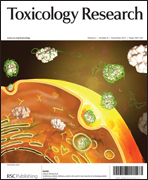Calmodulin–CaMKII mediated alteration of oxidative stress: interplay of the cAMP/PKA–ERK 1/2-NF-κB–NO axis on arsenic-induced head kidney macrophage apoptosis
Abstract
Using the head kidney macrophages (HKM) from catfish (Clarias batrachus) we earlier demonstrated the role of calcium (Ca2+) and its dependent neutral protease calpain in arsenic-induced apoptosis. Here, we report the role of the CaM–CaMKII axis as an initiator of the process. With the help of specific assay kits and inhibitors we document the pro-apoptotic role of CaM and CaMKII in arsenic-induced HKM apoptosis. CaM-induced CaMKII activity influenced superoxide ion production in exposed cells with a consequent increase in intracellular cAMP levels. Using H-89, the specific inhibitor for PKA, we show for the first time the pro-apoptotic role of the cAMP/PKA pathway in arsenic-induced HKM apoptosis. We report the cAMP/PKA pathway to be critical for initiating downstream activation of MAPKs, namely ERK 1/2. The superoxide ions generated due to arsenic-stress also induce NF-κB activation in HKM. Inducible NOS activity and consequent NO production were evident in the exposed HKM and our study implicates the involvement of ERK 1/2 and NF-κB in the process. Arsenic exposure alters mitochondrial membrane potential, releases cytochrome C and activates caspase-9 leading to caspase-3 mediated apoptosis of HKM. Our findings, thus, provide insight into the underlying mechanism of arsenic toxicity and indicate that HKM could serve as an important in vitro model for immunotoxicity assays.


 Please wait while we load your content...
Please wait while we load your content...